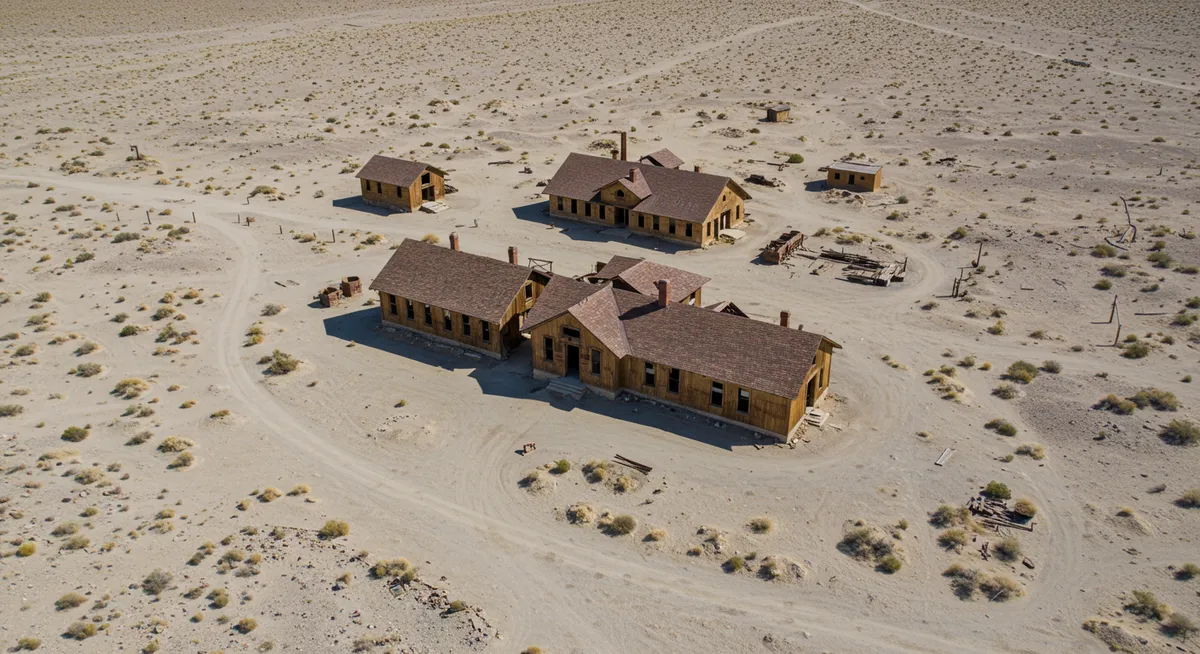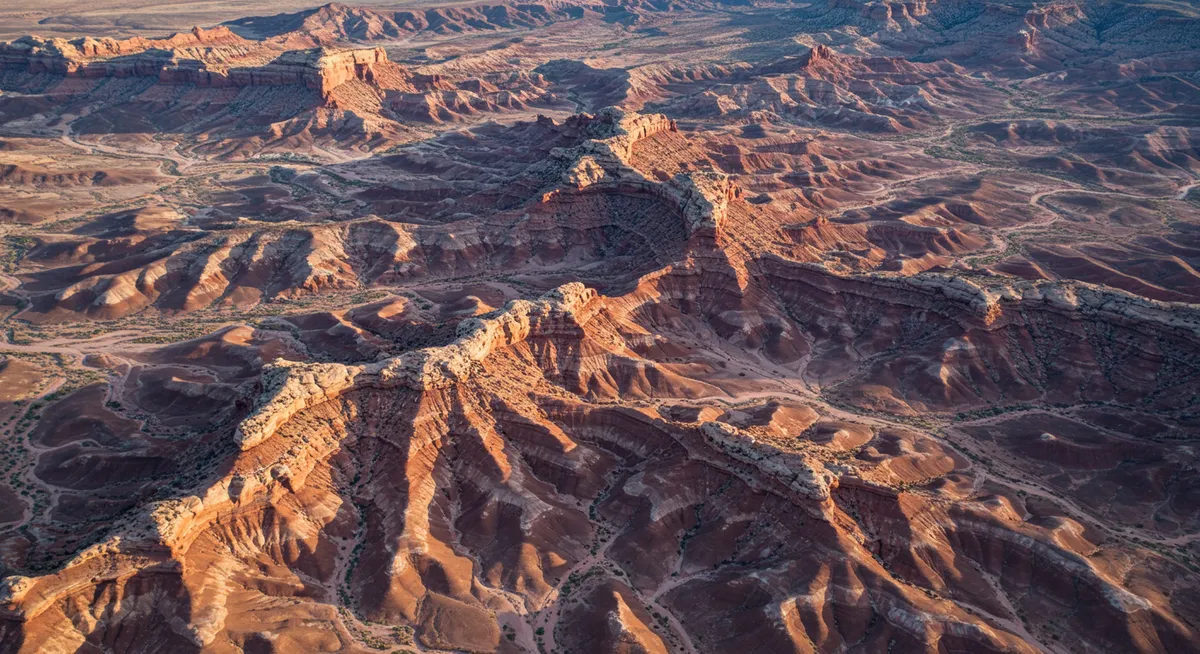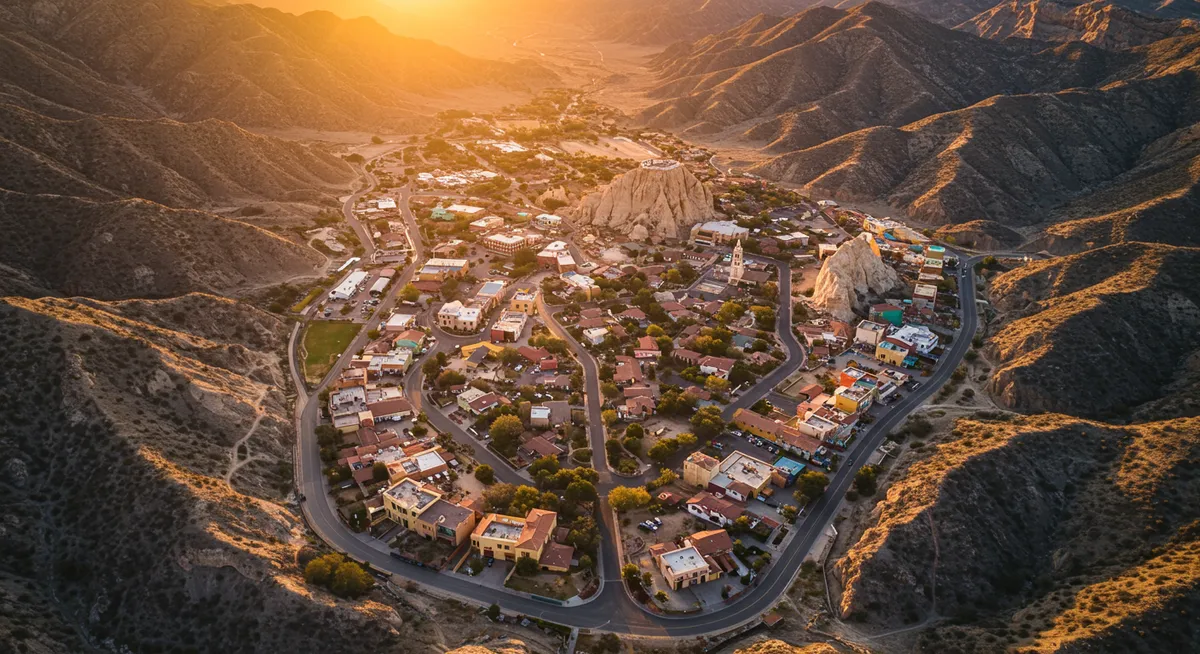Rhyolite, Nevada: The Boom That Went Bust

Rhyolite, Nevada: The Boom That Went Bust
In the heart of the Bullfrog Mining District, just a few miles west of Death Valley National Park, stands Rhyolite—one of the most dramatic ghost towns of the American West. What makes Rhyolite particularly compelling is the speed of its rise and fall; in just a few short years, it transformed from barren desert to a thriving metropolis of 10,000 people, then back to abandonment. Today, its crumbling banks, train depot, and unique bottle house offer a haunting testament to the fleeting nature of boom-and-bust mining economies that shaped much of the American frontier.

The Meteoric Rise: 1905-1907
Unlike many western mining settlements that grew organically over decades, Rhyolite's development was explosive. When prospectors Shorty Harris and Ed Cross discovered gold in the nearby hills in 1904, word spread rapidly through mining circuits. Within just six months of the initial gold discovery, the town's population swelled to 1,200 people. A year later, it reached 2,500, and by 1907—at its peak—Rhyolite housed approximately 10,000 residents.
What made Rhyolite so extraordinary was not just its rapid growth but the level of development that accompanied it. Unlike the rough-hewn buildings typical of hastily constructed mining camps, Rhyolite boasted:
Modern Infrastructure
- Electric lights
- Water mains
- Telephone and telegraph lines
- Two electric plants
- An ice plant
Transportation Hub
Three railroad lines connected Rhyolite to the outside world:
- Las Vegas & Tonopah
- Tonopah & Tidewater
- Bullfrog Goldfield
Financial District
Several banks established branches, most notably the impressive three-story Cook Bank building:
- The Cook Bank building, constructed at a cost of $90,000 (equivalent to over $2.5 million today)
- The Porter Brothers Store, a large two-story building with plate glass windows
Civic Development
The town featured a concrete school building that accommodated 250 students, a hospital, an opera house, and a stock exchange:
- Concrete schoolhouse with modern amenities
- The impressive Mediterranean-style John S. Cook & Co. Building with imported Italian marble stairs
- The unique Bottle House, constructed by Tom Kelly using approximately 50,000 beer and liquor bottles embedded in mortar

The Spectacular Collapse: 1907-1916
Rhyolite's decline was as dramatic as its ascent. The Panic of 1907—a financial crisis that rippled across the nation—hit the young city particularly hard, causing investors to withdraw from mining operations. This economic shock, combined with lower-than-expected gold yields from the Montgomery Shoshone Mine, spelled disaster. Where towns like Bodie enjoyed decades of prosperity, Rhyolite barely had time to celebrate its growth before contraction began.
Financial Crisis and Mining Problems (1907)
The beginning of the end came with the financial panic of 1907, which dried up investment capital across the country. This coincided with disappointing results from the mines—ore quality was not living up to early samples, and extraction costs proved higher than anticipated. The leading mine, the Montgomery Shoshone, which had been purchased by industrialist Charles Schwab, began to underperform significantly despite heavy investment in infrastructure.
The Swift Exodus (1908-1910)
The decline happened with startling speed:
- By 1908, many mines were already operating at a loss
- In 1909, the Montgomery Shoshone mine closed completely
- Production at mines across the district declined by 74% between 1908 and 1910
- Newspapers folded, businesses closed, and residents departed en masse
- The power company shut off electricity to the town in 1916
- By 1920, fewer than 20 people remained
- The post office closed in 1924
The Last Days
By the mid-1920s, Rhyolite was effectively dead. Buildings were salvaged for materials, with components transported to nearby towns like Beatty. The Las Vegas & Tonopah Railroad removed its tracks. What couldn't be easily moved was left to the harsh desert elements. The town that had burst into existence with such vigor and optimism had disappeared almost as quickly, leaving behind only the most substantial structures as monuments to its brief existence.
What Remains Today
While most ghost towns of the American West have fallen victim to souvenir hunters, vandalism, and the ravages of time, Rhyolite's ruins remain substantial enough to provide visitors with a clear sense of the town's former grandeur. Key structures still visible include:
Major Structures
- The Cook Bank Building: The town's most photographed ruin, with portions of three walls still standing from what was once a grand three-story structure with marble floors
- The Porter Brothers Store: The facade and part of the two-story mercantile building survives
- The Bottle House: One of the few structures to survive largely intact, this unique building constructed from thousands of bottles has been restored several times
- Las Vegas & Tonopah Railroad Depot: The partially restored train station that once welcomed visitors to the booming town
- School Building: Portions of the concrete walls of the schoolhouse remain
- Jail: The steel-reinforced concrete jail still stands, a testament to the town's need for law enforcement during wild boom days
- Overbury Building: Remnants of the structure that once housed a market, post office, and mining company offices
The Train Depot
The Las Vegas and Tonopah Railroad Depot stands as one of the most complete and recognizable buildings in Rhyolite. This Spanish Colonial Revival structure once welcomed passengers from Las Vegas and beyond. Its distinctive architecture and relatively good state of preservation make it one of the most photographed spots in Rhyolite—a stark contrast to the more remote mining ghost towns that lack such impressive infrastructure remains.
Visiting Rhyolite Today
Rhyolite offers one of the most accessible ghost town experiences in the western United States. Located just 4 miles west of Beatty, Nevada, and approximately 35 miles from Death Valley National Park, it's easily reached via a paved road suitable for all vehicles. This accessibility stands in contrast to many other ghost towns that require four-wheel drive or lengthy hikes to visit.
Getting to Rhyolite
Rhyolite is easily accessible compared to many ghost towns:
- Location: The ghost town is located 4 miles west of Beatty, Nevada, and about 35 miles from the entrance to Death Valley National Park
- Access: Rhyolite is reached via a paved road (Rhyolite Road off Highway 374), making it accessible to all vehicles in good weather
- Nearest Services: The town of Beatty offers gas, food, and lodging
- Regional Context: Rhyolite makes an excellent stop when visiting Death Valley National Park or traveling between Las Vegas (120 miles southeast) and Reno (330 miles northwest)
Practical Information
Plan your visit with these considerations in mind:
- Operating Hours: The site is open 24 hours a day, 7 days a week
- Admission: Free, though donations to preservation efforts are appreciated
- Facilities: No services are available at the ghost town itself; bring water and supplies
- Safety: Stay out of unstable structures, watch for rattlesnakes in warm weather, and bring sun protection as shade is limited
- Climate Considerations: Summer temperatures frequently exceed 100°F (38°C); spring and fall offer more comfortable visiting conditions
- Photography: Early morning and late afternoon light dramatically enhance the ruins for photography
The Best Way to Experience Rhyolite
To get the most from your visit:
- Self-Guided Tour: Allow 1-2 hours to explore the ruins at a leisurely pace; informational signs provide historical context at major structures
- Photography Focus: The Cook Bank building is especially photogenic at sunrise and sunset when the warm light enhances the texture of the stone walls
- Broader Context: Visit the Beatty Museum in nearby Beatty for additional historical information about Rhyolite and the Bullfrog Mining District
- Art Exploration: Set aside time to experience the surreal sculptures at the adjacent Goldwell Open Air Museum
- Death Valley Connection: Consider pairing your visit with nearby ghost towns in Death Valley like Leadfield or the well-preserved buildings at Scotty's Castle (currently closed for flood repairs)
Photography Tips for Rhyolite
Rhyolite offers exceptional photographic opportunities that differ from many wooden ghost towns:
- Golden Hour Magic: The warm light of early morning and late afternoon dramatically enhances the texture and color of the stone ruins
- Night Photography: With minimal light pollution, Rhyolite offers excellent opportunities for star photography, including Milky Way shots behind the iconic ruins
- Framing Techniques: Use empty window and door frames in the ruins to create natural frames for Death Valley landscapes in the distance
- Perspectives: Experiment with shooting up at the tall walls to emphasize their scale and the builders' ambition
- Weather Opportunities: Rare storm clouds or rainbows over the desert setting create especially dramatic images
Beyond the Buildings: The Goldwell Open Air Museum
Adjacent to Rhyolite's ruins sits one of the most unexpected cultural attractions in the Nevada desert: the Goldwell Open Air Museum. This outdoor sculpture park, established in the 1980s by a collective of Belgian artists, features surreal installations that create a fascinating juxtaposition with the ghost town's crumbling structures. The most famous piece, "The Last Supper" by Albert Szukalski, depicts ghostly shrouded figures in a haunting tableau that seems to echo Rhyolite's own spectral presence—creating an artistic reflection on the cultural significance of Western ghost towns.

Historical Significance: Why Rhyolite Matters
Beyond its haunting visual appeal, Rhyolite offers important insights into Western American history:
A Cautionary Tale of Boom and Bust
Rhyolite represents the mining boom cycle in its most extreme form. While many ghost towns declined gradually over decades, Rhyolite's meteoric rise and fall occurred within a single decade. This compressed timeline makes it a perfect case study in speculative development and the dangers of unbridled optimism in resource-based economies.
The Role of Outside Capital
Unlike earlier mining rushes dominated by individual prospectors, Rhyolite exemplifies the era when Eastern and European capital transformed mining into big business. The substantial buildings and infrastructure reflect both the massive investment poured into the town and the catastrophic losses when those investments failed to pay off.
Architectural Legacy
The town's buildings represent an important transition in Western settlement patterns. Moving beyond the temporary structures of earlier booms, Rhyolite's developers built with permanence in mind, using modern materials and substantial designs that reflected urban architectural styles rather than frontier expediency.
Desert Adaptation
Features like the Bottle House showcase the resourcefulness required for desert living, where conventional building materials were scarce and expensive. Such adaptations reveal how settlers repurposed available materials in creative ways.

The Rhyolite Experience: What Makes This Ghost Town Unique
Each ghost town offers a different window into the past. Rhyolite's distinctive qualities include:
Distinctive Features
- Stone Ruins vs. Wooden Structures: Unlike wooden ghost towns that often appear to melt back into the landscape, Rhyolite's stone ruins create a more dramatic visual impact reminiscent of ancient sites
- Accessibility: Easy access via paved road makes Rhyolite more visitor-friendly than many remote ghost towns
- Death Valley Proximity: Location near one of America's most visited national parks ensures steady visitation and better preservation
- Artistic Connection: The adjacent Goldwell Open Air Museum creates a unique intersection of historical ruins and contemporary art
Visitor Experience
- Open Landscape: Unlike some ghost towns nestled in canyons or forests, Rhyolite's wide-open desert setting creates unobstructed views that emphasize the town's isolation
- Freedom to Explore: With fewer preservation restrictions than state park ghost towns, visitors can move freely among the ruins
- Photographic Drama: The combination of substantial ruins, desert light, and mountain backdrops creates exceptionally photogenic scenes
- Seasonal Variation: Different seasons transform the experience, from spring wildflowers to dramatic summer thunderstorms to crisp winter clarity
Beyond Rhyolite: Nearby Ghost Towns and Attractions
Rhyolite can be the centerpiece of a fascinating exploration of Death Valley's mining history:
Death Valley Ghost Towns
- Leadfield: A 1920s ghost town down the scenic Titus Canyon Road, notorious for its fraudulent promotion
- Skidoo: A high-elevation mining town within Death Valley National Park, with few remains but fascinating history
- Panamint City: For adventurous hikers, this remote ghost town deep in Surprise Canyon requires a strenuous trek
- Ballarat: A small supply town on the western edge of Death Valley with a few remaining structures
Other Regional Attractions
- Death Valley National Park: Explore the lowest, hottest, driest national park in the United States, with extraordinary desert landscapes
- Goldwell Open Air Museum: Adjacent to Rhyolite, featuring large-scale outdoor sculptures in a desert setting
- Beatty, Nevada: This small town near Rhyolite offers services and its own historical museum
- Amargosa Opera House: A unique cultural site in Death Valley Junction where dancer Marta Becket performed for decades
- Ash Meadows National Wildlife Refuge: Natural oasis with crystal-clear springs and endemic species
Plan Your Visit to Rhyolite
Experience one of America's most dramatic ghost towns, where grand stone buildings stand as monuments to unfulfilled dreams in the Nevada desert.
Related Ghost Town Experiences
If you're fascinated by Rhyolite, explore these other notable ghost towns in the American West:

Bodie, California
Explore America's best-preserved ghost town with over 200 buildings maintained in "arrested decay."

Silver Reef, Utah (Coming Soon)
Visit the unusual silver mining town built on sandstone—a geological rarity that created a thriving settlement.

Calico, California (Coming Soon)
Compare Rhyolite's authentic ruins with this reconstructed silver mining town now operating as a tourism attraction.